




Introduction to Scaling
Have you ever clicked a photo using mobile or any camera? What do you see? An image, right. This image represents the object that you clicked. But, can you tell me whether the size of the image clicked and the original size is equal? No. It is so because you have either scaled-up or scaled-down the object size. Representation of an image or object by enlarging or shrinking is called ‘scaling’ of the image or object.
What is Scaling in Math?
Scaling is the factor which is used to represent the object size. The size of the object can be shown by increasing or decreasing its original size. In general, the represent size of the object increased for the small object whereas it decreased for the bigger object. Scaling is used for better viewing of an object. The ratio by which an object’s size increased or decreased is called as scale factor.
What is a Scale Factor?
Scale factor is the ratio between corresponding measurement of an object and representation of that object. The scale factor is a whole number or greater than 1 to make a larger copy. The scale factor is a fraction or less than 1 to make a smaller copy. Therefore, scale factor can be expressed by any number or fraction. Also, scale factor can be expressed using colon (:), such as
Original sized object : Representation sized object
where, Representation sized object = Any number x Original sized object (in case of larger copy)
or, Representation sized object = \[ \frac{1}{Any \, number} \] x Original sized object (in case of smaller copy)
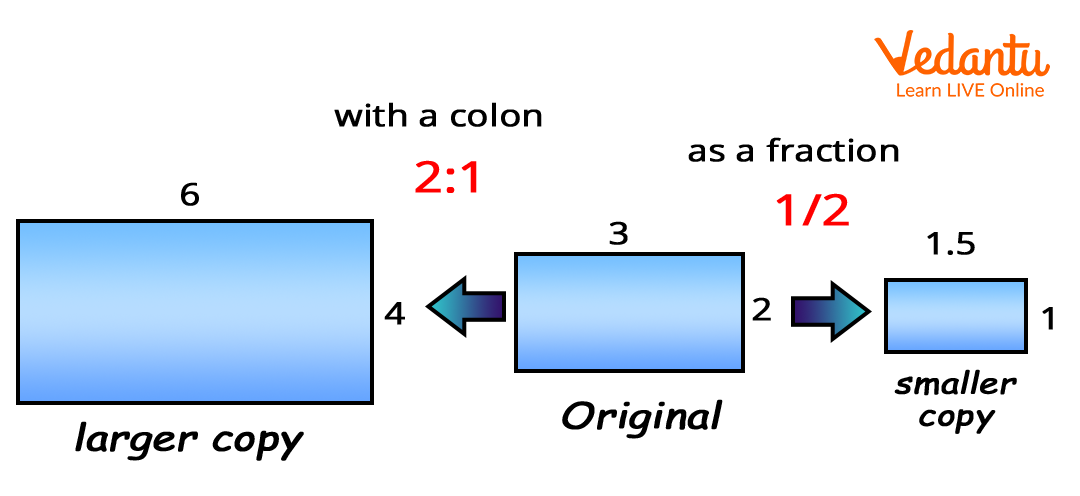
Scale factor
Types of Scale Factor
There are two types of scale factor:
Scale-up Factor
Scale-down Factor
Scale-up Factor: To show the larger size of a small-sized object, we multiply by a number to the original size of the object. In this case, we multiply with the a number greater than 1 to the original sized object. To find the scale-up factor, we used the following formula:
Scale - up (Smaller to larger) = {Larger figure measurement} ÷ {Smaller figure measurement}
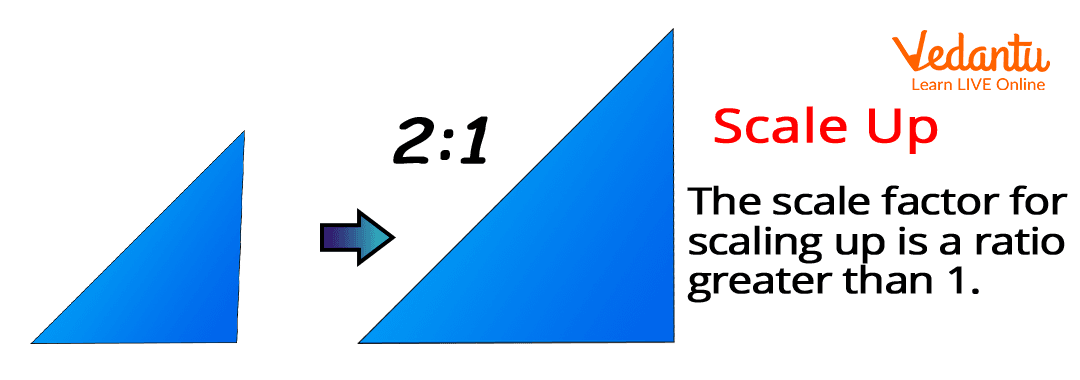
Scale Up
Scale-down Factor: To show the smaller size of a bigger-sized object, we divide by a number to the original size of the object. In this case, either we multiply with a number smaller than 1 or divide it by a number greater than 1 to the original sized object. To find the scale-down factor, we used the following formula:
Scale - down (larger to Smaller) = \[ \frac{Smaller \, figure \, measurement}{Larger \, figure \, measurement} \]
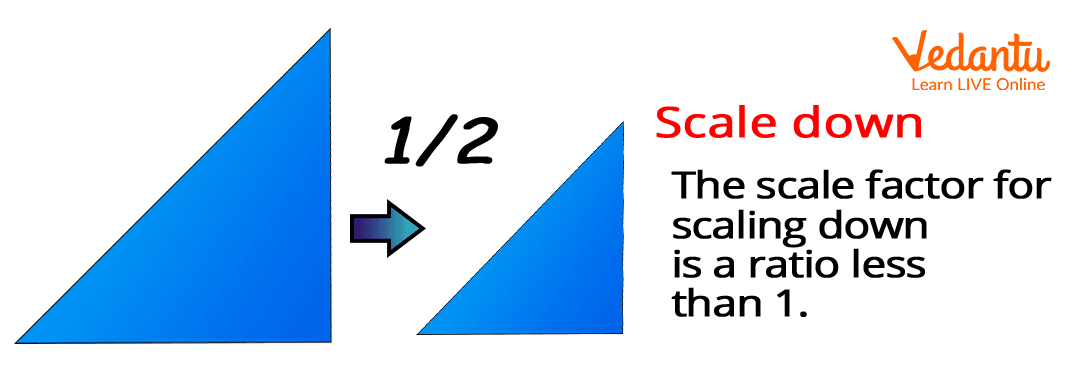
Scale down
Scaling in Geometry
In Geometry, scale factors can be obtained from similar figures, or we can create another image using the scale factor over the original figure.
Example of Scaling in Geometry: In this example, we show the scale-up factor. Here, a scale factor of 2 is shown, which means that the new figure obtained will be twice the original figure. All the sides of the triangle multiplied by 2 to obtain the new figure.
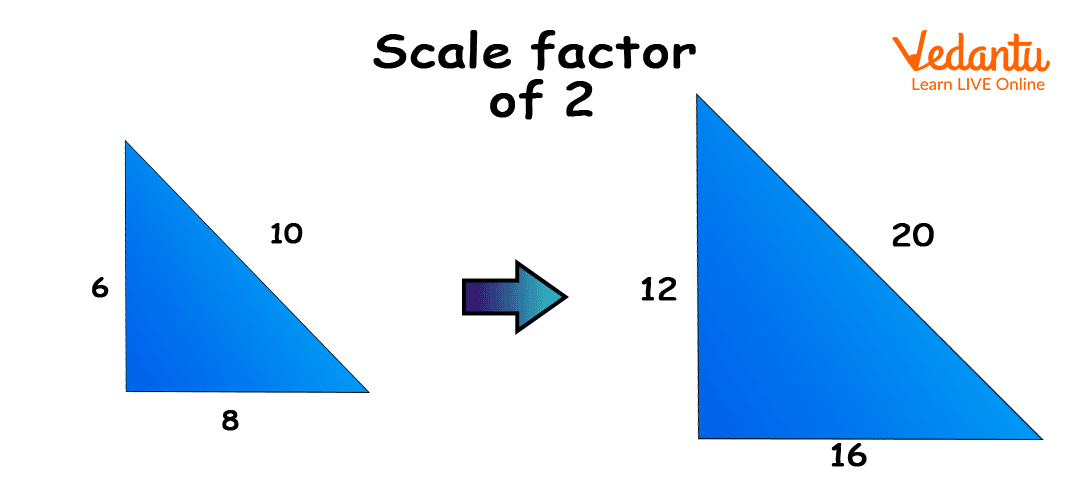
Scale factor of 2
Why 2? Lets see the above given figure. In the first figure, we can observe that value of base, height and hypotenuse are equal to 8, 6 and 10 respectively. In the second figure, values of these are 16, 12 and 20. Comparing both the figures, we can calculate scale factor as:
\[ Scale Factor = \frac{Base \, Measurement \, of \, New \, Figure}{Base \, Measurement \, of \, Old \, Figure } = \frac{16}{8} = 2 \]
\[ Scale Factor = \frac{Height \, Measurement \, of \, New \, Figure}{Height \, Measurement \, of \, Old \, Figure} = \frac{12}{6} = 2 \]
\[ Scale Factor= \frac{Hypotenuse \, Measurement \, of \, New \, Figure}{Hypotenuse \, Measurement \, of \, Old \, Figure} = \frac{16}{8} = 2 \]
Hence, the scale factor is 2.
Now, let us consider another example to understand it more.
Example: What is the scale factor from ΔABC to ΔDEF?
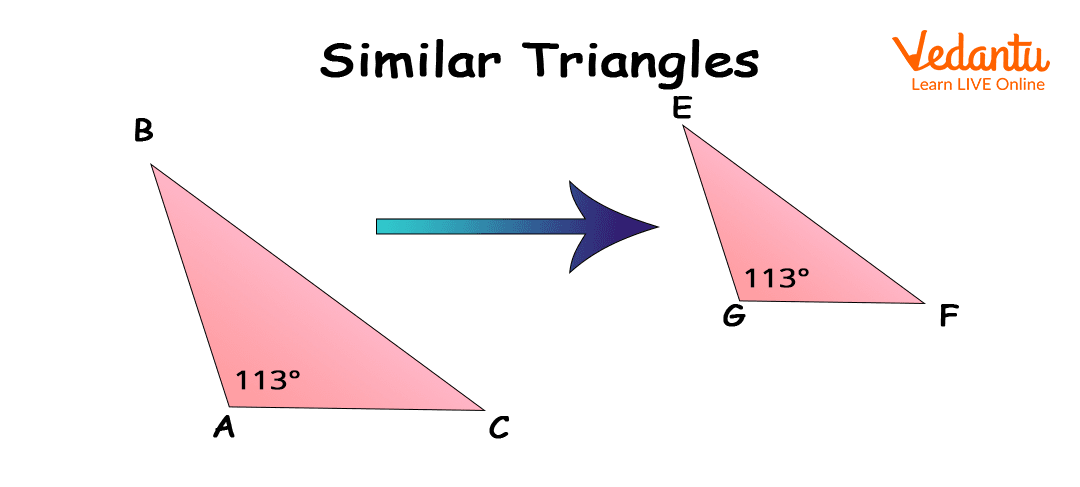
How to find the scale factor?
From the above-given figures, we can easily observe that the values of all sides are decreasing. So, here we need to find the scale-down factor. The point to be noted is that we can find the scale factor using the ratios of respective sides/same sides of both the triangles.
\[ Scale Factor= \frac{Measurement \, of \, Side \, EF (New \, Figure)}{Measurement \, of \, Side BC (Old \, Figure)} = \frac{12}{18} = 0.66666 \]
Remember: We can find the scale factor of an image using the values of corresponding sides, angles and diagonals.
Conclusion
From this article, we have learnt the meaning of scaling and types of scale factor. We also learn how to find the value of scale factor. To know more mathematical terms, visit our website.
FAQs on Scaling in Math
1. What does scaling mean in mathematics?
In mathematics, scaling is a linear transformation that uniformly enlarges (scales up) or shrinks (scales down) an object. Every dimension of the object is multiplied by the same constant number, known as the scale factor. This process changes the size of the object but preserves its shape, angles, and proportions.
2. What is a scale factor and how does its value determine the result?
A scale factor is the constant ratio by which an object's size is changed during scaling. The effect of the scale factor (k) is as follows:
- If k > 1, the object is enlarged. This is called scaling up.
- If 0 < k < 1, the object is shrunk. This is called scaling down.
- If k = 1, the object's size remains unchanged; the scaled image is identical to the original.
3. What is the basic formula for scaling?
The formula for scaling depends on the context. For scaling the coordinates of a point (x, y) by a scale factor 'k' with respect to the origin, the new coordinates (x', y') are calculated as:
x' = k * x
y' = k * y
For a simple length 'L', the new scaled length 'L'' is simply L' = k * L.
4. What is the difference between scaling up and scaling down?
The primary difference lies in the scale factor used and the resulting size. Scaling up, or enlargement, occurs when the scale factor is greater than 1, making the new object larger than the original. In contrast, scaling down, or reduction, occurs when the scale factor is between 0 and 1, making the new object smaller.
5. Can you provide a real-world example of scaling?
A common example of scaling is creating maps. A map is a scaled-down representation of a large geographical area. The map's scale (e.g., 1:100,000) is the scale factor, indicating that 1 unit of distance on the map represents 100,000 units in reality. This allows large areas to be viewed on a small sheet of paper while maintaining accurate proportions.
6. How does scaling affect the area and volume of an object?
Scaling does not affect area and volume linearly. If a 2D shape is scaled by a factor of 'k', its area changes by a factor of k². If a 3D object is scaled by a factor of 'k', its volume changes by a factor of k³. For example, doubling the side lengths of a cube (k=2) increases its area by 4 times and its volume by 8 times.
7. How is multiplication used to perform scaling on a shape's coordinates?
Multiplication is the fundamental operation for scaling in coordinate geometry. To scale a shape, you multiply the coordinates of each of its vertices by the scale factor. For instance, to double the size of a triangle with vertices at (1,2), (3,1), and (2,4), you would multiply each coordinate by 2, resulting in new vertices at (2,4), (6,2), and (4,8).
8. What is the importance of scaling in fields like engineering and computer graphics?
Scaling is crucial in many professional fields.
- In engineering, it's used to create blueprints and models of large structures like bridges or tiny components like microchips. This allows for detailed analysis and design before construction.
- In computer graphics, scaling is used to zoom in or out, resize windows and images, and create realistic 3D models that can be viewed from different distances.
9. What is the difference between scaling and resizing an image?
While often used interchangeably, there is a technical difference. Scaling is a uniform transformation, meaning it applies the same scale factor to all dimensions, preserving the aspect ratio (the proportion between width and height). Resizing can be non-uniform; you could change the width by one factor and the height by another, which would stretch or squash the image, distorting its original proportions.
10. Can an object be scaled by a negative scale factor, and what does it represent?
Yes, scaling by a negative scale factor is possible and represents two transformations in one: a scaling and a reflection. The object is first scaled by the absolute value of the factor and then reflected through the origin (the point of scaling). For example, applying a scale factor of -2 to a point (3, 4) would result in a new point at (-6, -8), which is twice as far from the origin and in the opposite direction.









